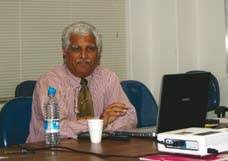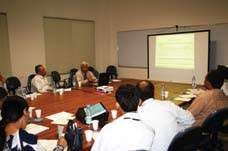
“Unless we invest in reform and modernization of public sector education,
health and skill development, reformulate family planning and healthcare,
population indicators are not likely to improve.”
Exploring the history of population planning, Shafqat hypothesized the impact of the Cold War on family planning programs. He argued that following World War II, the advanced industrial states saw rising populations in the Third World as a threat and thus provided extensive help to formulate family planning policies. India was the first nation to introduce family planning policy while in Pakistan, President Ayub Khan’s era (1959-69) was both hey day of family planning as well as Pakistan’s alliance with the US. In the 1960’s the US linked foreign aid with adoption of family planning/population control programs in the developing countries. Shafqat argued that such externally influenced population policy formulation did not take into account the cultural context and existing indigenous value structures resultantly the emphasis on contraceptive use and controlling birth rates was resisted. During the 1970’s problems of the State and break up of Pakistan had overwhelming social and political consequences and managing population growth rates remained a low priority, however, gender mainstreaming, women representation and social permissiveness made women more visible.
During General Zia-ul- Haq’s era (1977-88), there was a benign neglect of population issues as the regime strengthened by the heightened Cold War and alliance with the US, patronized conservative religious forces domestically and went through an orgy of ‘Islamization’ that showed contemptuous disregard for family planning issues. Unfortunately the promoted brand of Islamization was averse to gender mainstreaming, population welfare and respect for human rights. While the 1990s saw a battle for survival between the dominant political parties (PPP and PML-N); who indulged in outbidding each other rather than devising a coherent population policy.
In the post 9-11 scenarios, the situation has all together changed because governance in Pakistan is no longer an internal issue and claims about upholding sovereignty is only organized hypocrisy. Governance has been redefined in the post 9-11 scenario as international collaboration and funding support have been dominated by US – Pakistan strategic partnership. Being faced with challenges treincluding territorial integrity and blowback of being the frontline state against the ‘war on terror’, the role of the military has changed from Huntingtonian model of professionalism to Janowitzian model of Constabulary functions including policing and counter insurgency. The out come has been that concerns about citizen security, law and order and establishing the writ of state gained urgency while policies related to citizen welfare—small healthy family, poverty alleviation, investment in education and skill development continue to be treated as low priority areas. The challenge is to restore a balance between the security needs of the state and welfare demands of the population.
Though there has been collaboration in professional skills development, governance & legal capacity building and education reform & youth through US Aid programs, still the dominant areas of partnership have been security oriented such as counter narcotics, terrorism, money laundering, human trafficking, police and legal reforms. Institutional linkages remain concentrated in military establishments, US State Department Joint Working Group on terrorism, the US Bureau of International Narcotics & Law Enforcement as bilateral agreements between US and Pakistani ministries.
Shafqat then shifted his analysis to the current demographic reality of the country. Illustrating the case of education and health, Shafqat took an Alarmist position and said it is imperative that by 2010 Pakistan add 155,000 extra teachers in the elementary sub-sector and 20,000 each in the secondary and higher secondary sectors. Similarly 175,000 additional doctors, 40,000 nurses and 35,000 hospital beds costing to the tune of Rs 14 billion are required. These are but requisite needs for generating the Human Capital required to manage the demographic transition, not to talk of employment generation to provide a source of livelihood to millions joining the work force every year. Shafqat argued that unnecessary attention has been placed on the less than 5% minority, either the Geeks – the extremely small, bright and privileged who go to top private universities (LUMS, FAST, GIK etc.) predominantly ending up in the global market or the noisy Madrassa educated – a segment of which supposedly adopts a militant route. Instead, the real challenge lies with the 80% (public sector education) who go to government schools and continue to make up the backbone of the governance structure of the country. If the State does not provide the necessary skills to this bulk of youth, citizen and state security will most definitely become a cause of concern.
This demands investment in improving the quality of manpower to promote conditions that in turn lead to equity, justice and empowerment. If this opportunity is missed the countervailing forces will gain momentum and keep our focus on the issues of security. It merits attention that Pakistan military is the largest state employer (600,000 employees) and not educators and healthcare providers. This needs to change. It demands a clear and sharper focus on employment generation strategies for youth, whereby the State and private sector could develop a shared vision on youth employment and voluntary social services.
“The real challenge lies with the 80% (public sector education)
who go to government schools and continue to make up the
backbone of the governance structure of the country”
Falling fertility and rising longevity of life is a global trend. This trend is a cause of concern for the advanced industrial states, where it is projected that in the next 50 years aging of population could create geopolitical implications. As population decline and aging emerge as dominant trends in the advanced industrial states and huge youth bulges in the developing countries, they offer an opportunity for both. In Pakistan where fertility is still high (declining from 5.6% in 1992 to 4.1 % in 2006) and life expectancy is also improving, it is the emerging youth bulge that is likely to create new opportunities and challenges. Currently newspaper headlines of illegally migrating Pakistanis being deported from across Europe and Gulf States is a stark reminder of the challenge; it is now time to invest in improving the skills of our youth to cash upon the opportunity offered by aging in advanced industrial states. The aging population in the West provides tremendous employment opportunities in nursing, health technologies and other service industries. But availing this opportunity requires planning and heavy investment in selected sectors as currently being done by Costa Rica and the Philippines. Similarly skills up-gradation of large sections of service industry including carpenters, mechanics and others would also relieve some stress on internal resources through jobs in developing economies of the Gulf. As a global power US is increasingly realizing that waging a war against global terrorism also means combating a prolonged insurgency. It demands large troop deployment (youth manpower). Similarly occupation of a territory also demands troop deployment, and the entire nation building and re-construction project means large manpower availability. NATO countries faced with declining population can not afford to deploy their troops and get them killed (earlier this year when 10 French soldiers were killed in Afghanistan, the French president Sarkozy rushed to Kabul to show solidarity and share grief). While in the case of US, disengaging from combat in Iraq to focus on Afghanistan demands more troops and manpower. If one makes a count of US deaths in Iraq and Afghanistan, besides the Blacks there is a significant number of Latinos among the troops. These Latino youth (Mexico, Nicaragua, and other Latin American countries) migrants to the US, in some cases opted for military as GI’s for a better life. There are reports that some were awarded citizenship posthumously. Global terrorism and US response has radicalized a small segment of Pakistani youth who are becoming increasingly vulnerable to religious militants. This vulnerability can be converted into an opportunity, if adopting a pragmatic approach, Pakistan were to train and export its manpower for employment opportunities in the American defense industry, thus linking the prospects of youth immigration with skill development, vocational and civic education and better economic prospects.

Participants at the seminar
Towards conclusion, Shafqat stated that demographic changes, particularly in age structures, could cause or support violence, security threats and crises of governance. But in a society like ours, territorial disputes (with India and now Afghanistan), ethnic contest (the Pushtoon, Baluch, Sindhi, Mohajir & Punjabi ), competing visions about the very basis of Pakistani state and absence of consensus on the nature and direction of political system could exacerbate existing tensions, thus increasing probability of violence, security threats and conditions that permeate corruption and mismanagement. Adding another hypothesis, he argued that the basis of discourse within a society also affects the way it responds to challenges of population growth. He drew a distinction between belief and knowledge based societies. To a considerable degree he argued that there is an overlap of belief and knowledge base in most societies, but he was emphatic in suggesting that increasingly Pakistan has drifted towards a belief based society. And this has constricted the development of rational thinking and consciousness. He provided an example of the destruction caused by the October 2005 earthquake in the northern areas of the country when innumerable voices explained it as the wrath of God rather than an outcome of ecological destruction, underdeveloped and unregulated infrastructure, and lack of calamity preparedness. This demands not only reform of Madrassa curricula but also focusing on the training of Imam of the Mosque (prayer leader) so that he is able to educate, inform and reassure the grief stricken and the shocked, rather than to aggravate their fears.
It is thus necessary to evaluate demographic change in the context of these political and socio-cultural concerns where it resonates as a governance and security issue deserving policy makers’ attention. Doctors and demographers have contributed enormously towards enhancing our understanding about family planning and reproductive health concerns. Now changing age structure and emerging youth bulge demand a paradigm shift in reframing of population issues so that they encompass broader quality of life concerns. Bluntly put a population laden with human capital would be considered an asset while that producing suicide bombers and Jehadis would be a liability deepening reputation crises for the Pakistani State and society. If we miss this decade, we could miss the 21st Century!
Citations

